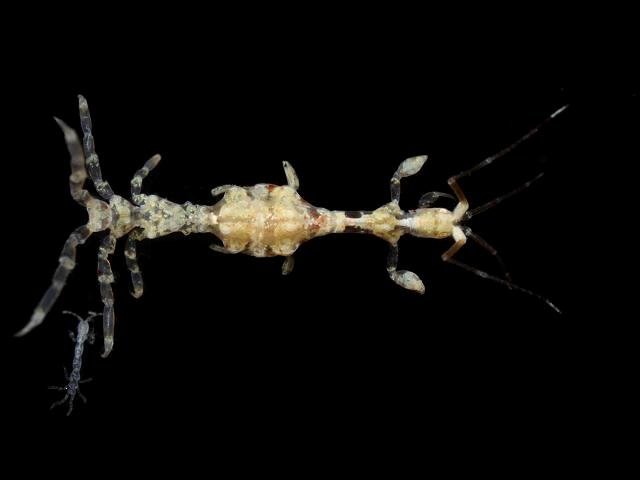
APHOTOMARINE
An educational resource dedicated mainly to the photography
and diversity of marine life that can be found in coastal waters
and intertidal areas of Great Britain and Ireland by David Fenwick.

Caprella cf. acanthifera Leach, 1814 - A caprellid amphipod or skeleton shrimp (Amphipod images)
Scroll down and rollover titles to change screen image or click on title to view image.
Skeleton shrimp
Caprella cf. acanthifera
- dorsal view 1
Caprella cf. acanthifera
- dorsal view 1
Skeleton shrimp
Caprella cf. acanthifera
- lateral view 2
Skeleton shrimp
Caprella cf. acanthifera
- lateral view head 1
Skeleton shrimp
Caprella cf. acanthifera
- dorsal view on algae 1
Specimen above found at Trevaunance Cove, near St. Agnes, Cornwall. 22.09.13. Note the specimen has few hairs, small gnathopod 2s and also a short neck.
Skeleton shrimp
Caprella cf. acanthifera
- female dorsal view 1
Skeleton shrimp
Caprella cf. acanthifera
- brood chamber of female 1
Skeleton shrimp
Caprella cf. acanthifera
- egg / 0.1mm division rule 1
Female specimen above found in a deep middleshore pool on Coral Weed at Battery Rocks, Penzance, Cornwall. 02.04.17.
Skeleton shrimp
Caprella cf. acanthifera
- white / lateral view 1
Skeleton shrimp
Caprella cf. acanthifera
- white / laterial anterior 1
Skeleton shrimp
Caprella cf. acanthifera
- white / gnathopod 2 -1
Skeleton shrimp
Caprella cf. acanthifera
- red / dorsal view 1
Skeleton shrimp
Caprella cf. acanthifera
- dorsal view spine pair 1
Skeleton shrimp
Caprella cf. acanthifera
- red / gnathopod 2 -1
The two specimens above, which are clearly different, were found at Battery Rocks, Penzance, Cornwall, 23.06.17.
I asked Dr. José Manuel Guerra García of the Laboratorio de Biología Marina, Universidad de Sevilla, Spain, who is a specialist in this field, about the two specimens displayed here. Dr. Guerra García kindly informed me that Caprella acanthifera was a complex and that specimens presented should be regarded as Caprella cf. acanthifera. He also informed me that he is currently involved with molecular studies involving this complex.
It seems to me from this that there is considerable variation within this complex, the common feature though would seem to be the presence of tubercules along the body, but not on the head. Tubercules should not be confused with either larger or small spikes or spines.
Other images of Caprella cf. acanthifera
Skeleton shrimp
Caprella cf. acanthifera
- lateral view 3
Specimen found in bryozoan sample taken from the lowershore on a spit north of Smeaton's Pier, St. Ives, Cornwall. 10.10.14.

The main objective of this website is in furthering environmental awareness and education through the medium of photography. To increase awareness and access to the wildlife of the region and help
people find and identify it. Sometimes the difference between species is obvious but many species can only be determined by observing microscopic characteristics that are specific to any one species.